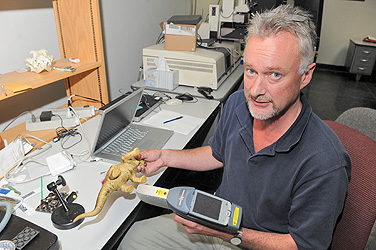Close Up
Using technology to solve mysteries

Peter Bush uses a portable X-ray fluorescence unit to determine the lead content of a toy dinosaur that had been brought to the South Campus Instrumentation Center by a concerned grandmother. Photo: NANCY J. PARISI
-
 Print
Print -
 Comments
Comments
-
“Part of the challenge and enjoyment of this position is the continual variety of both clients and analytical questions that are asked, samples that are brought.”
The fist-sized hunk of metal or stone found on an Iowa railroad track could have been extraterrestrial, a fragment of the Estherville meteorite that had fallen to Earth from space in May of 1879. If so, the nugget would qualify as a precious object, rare and expensive. On one well-known collector’s Web site, a half-ounce chunk of the meteorite is listed for $964. So with hopes high, the owner of the fist-sized find sent a specimen to UB scientist Peter Bush to inspect. Was the rock a treasure—a piece of the heavens that had come hurtling down to Earth more than a century before—or just some worthless lump of rubbish?
The request to investigate the possible meteorite is just one of many oddball inquiries Bush has fielded in 18 years as director of the School of Dental Medicine’s South Campus Instrumentation Center. With an array of equipment ranging from an X-ray fluorescence spectrometer to a $615,000 scanning electron microscope, he has analyzed everything from toilet paper to the Book of Mormon. The laboratory is widely recognized for work in dental forensics—in analyzing teeth and filling materials to identify human remains. But the lesser-known, sometimes bizarre projects the facility takes on also are a source of satisfaction for Bush, who is married to Mary Bush, an assistant professor of restorative dentistry in the dental school.
“Part of the challenge and enjoyment of this position is the continual variety of both clients and analytical questions that are asked, samples that are brought,” he says.
UB scientists and private companies pay to use the instrument center’s equipment or to have staff there conduct research. Five or six times a year, members of the public come to Bush with a question. Some bring their queries in person to the laboratory in the basement of Squire Hall. Others send items by mail. Several have reached Bush through curators at the Buffalo Museum of Science, where he volunteered after immigrating to the United States from England in 1981. He completes small jobs, pro bono, for people in the community who approach him, contributing to UB’s public service mission.
“I rarely turn anybody down,” says Bush, who earned a bachelor’s degree in electron microscopy in 1979 from the Polytechnic of the South Bank, known today as London South Bank University. “It depends on the possibility of doing an analysis. If it’s impossible to analyze, then we can’t do it. And also, if the job is a huge one and entails a lot of samples, that becomes problematic. That hasn’t happened.”
That attitude has benefited not only the surrounding community, but a long succession of students who have worked in the instrument center.
“I love it,” says Robyn Giebler, a laboratory assistant studying to become a dentist. “It’s a lot of fun because so many different things come in. …One day we could be looking at copper samples and the next we could be looking at bat flies.”
At UB, Bush’s world revolves around that which is invisible to the naked, human eye. Lab equipment allows him to describe materials’ elemental composition and look at objects only a few atoms wide. In a project a product-testing company commissioned, Bush used a scanning electron microscope to examine the fibers of a sample of recycled toilet paper, determining it was rougher than a conventional specimen. Employing the same technology, he found that a scrap of paper an art conservator sent him from the Book of Mormon was of poor quality, with loosely woven fibers. When a Buffalo business wanted to know why a knife sharpener it sold had a shorter-than-expected lifespan, Bush had an answer. Whereas the device’s surface should have consisted of synthetic diamond embedded in nickel, an image Bush captured of the product’s microstructure revealed the presence of alumina, a weaker abrasive.
Bush says that for many people, his instrument center serves as the unfortunate “lab of truth.” He has disappointed graduate students researching nanotechnology by informing them that materials they created in the lab were large enough to be measured in microns. In the case of the potential Estherville meteorite, Bush’s verdict also must have been a letdown. He concluded that the mystery object contained man-made chemical compounds. He recognized the rock as a piece of slag, a byproduct of smelting that sells by the ton.
“I think (the owner) must have been disappointed,” Bush says. “I sent him a report by mail. This kind of small stuff I do for free because it’s really simple analysis. It’s not time-consuming and usually, it’s one quick look and you can determine the issue.”
Asked why he is so open to helping strangers answer strange questions, Bush responds simply. “You would, wouldn’t you? It’s curiosity, as well. I’m interested in seeing this stuff.”

Reader Comments